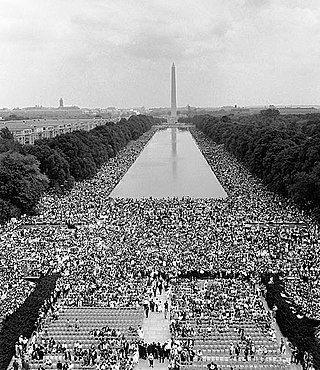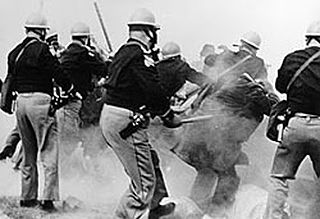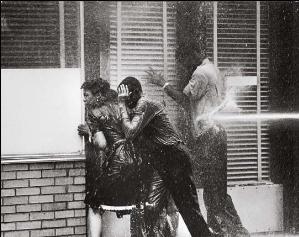Related Research Articles

Martin Luther King Jr. was an American Baptist minister and activist who was one of the most prominent leaders in the civil rights movement from 1955 until his assassination in 1968. A Black church leader and a son of early civil rights activist and minister Martin Luther King Sr., King advanced civil rights for people of color in the United States through nonviolence and civil disobedience. Inspired by his Christian beliefs and the nonviolent activism of Mahatma Gandhi, he led targeted, nonviolent resistance against Jim Crow laws and other forms of discrimination in the United States.

The civil rights movement was a nonviolent social movement and campaign from 1954 to 1968 in the United States to abolish legalized racial segregation, discrimination, and disenfranchisement throughout the United States. The movement had its origins in the Reconstruction era during the late 19th century, although it made its largest legislative gains in the 1960s after years of direct actions and grassroots protests. The social movement's major nonviolent resistance and civil disobedience campaigns eventually secured new protections in federal law for the civil rights of all Americans.

The March on Washington for Jobs and Freedom, also known as simply the March on Washington or The Great March on Washington, was held in Washington, D.C., on August 28, 1963. The purpose of the march was to advocate for the civil and economic rights of African Americans. At the march, final speaker Dr. Martin Luther King Jr., standing in front of the Lincoln Memorial, delivered his historic "I Have a Dream" speech in which he called for an end to racism.

Walter Philip Reuther was an American leader of organized labor and civil rights activist who built the United Automobile Workers (UAW) into one of the most progressive labor unions in American history. He saw labor movements not as narrow special interest groups but as instruments to advance social justice and human rights in democratic societies. He leveraged the UAW's resources and influence to advocate for workers' rights, civil rights, women's rights, universal health care, public education, affordable housing, environmental stewardship and nuclear nonproliferation around the world. He believed in Swedish-style social democracy and societal change through nonviolent civil disobedience. He cofounded the AFL-CIO in 1955 with George Meany. He survived two attempted assassinations, including one at home where he was struck by a 12-gauge shotgun blast fired through his kitchen window. He was the fourth and longest serving president of the UAW, serving from 1946 until his death in 1970.

The Southern Christian Leadership Conference (SCLC) is an African-American civil rights organization based in Atlanta, Georgia. SCLC is closely associated with its first president, Martin Luther King Jr., who had a large role in the American civil rights movement.

The Selma to Montgomery marches were three protest marches, held in 1965, along the 54-mile (87 km) highway from Selma, Alabama, to the state capital of Montgomery. The marches were organized by nonviolent activists to demonstrate the desire of African-American citizens to exercise their constitutional right to vote, in defiance of segregationist repression; they were part of a broader voting rights movement underway in Selma and throughout the American South. By highlighting racial injustice, they contributed to passage that year of the Voting Rights Act, a landmark federal achievement of the civil rights movement.

Viola Fauver Liuzzo was an American civil rights activist. In March 1965, Liuzzo heeded the call of Martin Luther King Jr. and traveled from Detroit, Michigan, to Selma, Alabama, in the wake of the Bloody Sunday attempt at marching across the Edmund Pettus Bridge. Liuzzo participated in the successful Selma to Montgomery marches and helped with coordination and logistics. At the age of 39, while driving back from a trip shuttling fellow activists to the Montgomery airport, she was fatally hit by shots fired from a pursuing car containing Ku Klux Klan members Collie Leroy Wilkins, Jr., William Orville Eaton, Eugene Thomas, and Gary Thomas Rowe, the last of whom was actually an undercover informant working for the Federal Bureau of Investigation (FBI). Although the State of Alabama was unable to secure a murder conviction, Wilkins, Eaton, and Thomas were charged in federal court with conspiracy to intimidate African Americans under the 1871 Ku Klux Klan Act, a Reconstruction civil rights statute. On December 3, the trio was found guilty by an all-white, all-male jury, and were sentenced to ten years in prison, a landmark in Southern legal history.

The March Against Fear was a major 1966 demonstration in the Civil Rights Movement in the South. Activist James Meredith launched the event on June 5, 1966, intending to make a solitary walk from Memphis, Tennessee, to Jackson, Mississippi via the Mississippi Delta, starting at Memphis's Peabody Hotel and proceeding to the Mississippi state line, then continuing through, respectively, the Mississippi cities of Hernando, Grenada, Greenwood, Indianola, Belzoni, Yazoo City, and Canton before arriving at Jackson's City Hall. The total distance marched was approximately 270 miles over a period of 21 days. The goal was to counter the continuing racism in the Mississippi Delta after passage of federal civil rights legislation in the previous two years and to encourage African Americans in the state to register to vote. He invited only individual black men to join him and did not want it to be a large media event dominated by major civil rights organizations.

The Big Six—Martin Luther King Jr., James Farmer, John Lewis, A. Philip Randolph, Roy Wilkins and Whitney Young—were the leaders of six prominent civil rights organizations who were instrumental in the organization of the March on Washington for Jobs and Freedom in 1963, at the height of the Civil Rights Movement in the United States.

The Poor People's Campaign, or Poor People's March on Washington, was a 1968 effort to gain economic justice for poor people in the United States. It was organized by Martin Luther King Jr. and the Southern Christian Leadership Conference (SCLC), and carried out under the leadership of Ralph Abernathy in the wake of King's assassination in April 1968.

The Birmingham campaign, also known as the Birmingham movement or Birmingham confrontation, was an American movement organized in early 1963 by the Southern Christian Leadership Conference (SCLC) to bring attention to the integration efforts of African Americans in Birmingham, Alabama.

The Memphis sanitation strike began on February 12, 1968, in response to the deaths of sanitation workers Echol Cole and Robert Walker. The deaths served as a breaking point for more than 1,300 African American men from the Memphis Department of Public Works as they demanded higher wages, time and a half overtime, dues check-off, safety measures, and pay for the rainy days when they were told to go home. The Memphis sanitation strike was led by T.O. Jones and had the support of Jerry Wurf, president of the American Federation of State, County, and Municipal Employees (AFSCME) and the local branch of the National Association for the Advancement of Colored People (NAACP). The AFSCME was chartered in 1964 by the state; the city of Memphis refused to recognize it. This resulted in the second sanitation Worker Strike in 1968 which began because of several incidents that led the employees to strike. Mayor Henry Loeb refused to recognize the strike and rejected the City Council vote, insisting that only he possessed the power to recognize the union. The Memphis sanitation strike prompted Martin Luther King Jr.'s presence, where he famously gave the “I’ve Been to the Mountaintop” speech a day before his assassination.

"I Have a Dream" is a public speech that was delivered by American civil rights activist and Baptist minister Martin Luther King Jr. during the March on Washington for Jobs and Freedom on August 28, 1963. In the speech, King called for civil and economic rights and an end to racism in the United States. Delivered to over 250,000 civil rights supporters from the steps of the Lincoln Memorial in Washington, D.C., the speech was one of the most famous moments of the civil rights movement and among the most iconic speeches in American history.
The Prayer Pilgrimage for Freedom, or Prayer Pilgrimage to Washington, was a 1957 demonstration in Washington, D.C., an early event in the Civil Rights Movement of the 1950s and 1960s. It was the occasion for Martin Luther King Jr.'s Give Us the Ballot speech.

The St. Augustine movement was a part of the wider Civil Rights Movement, taking place in St. Augustine, Florida from 1963 to 1964. It was a major event in the city's long history and had a role in the passage of the Civil Rights Act of 1964.
Bernard Lee was an activist and member of the Southern Christian Leadership Conference during the Civil Rights Movement. He was a key associate of Martin Luther King Jr.

Golden Asro Frinks was an American civil rights activist and a Southern Christian Leadership Conference (SCLC) field secretary who represented the New Bern, North Carolina SCLC chapter. He is best known as a principal civil rights organizer in North Carolina during the 1960s.

New Bethel Baptist Church is a Baptist church located at 8430 C. L. Franklin Boulevard in Detroit, Michigan. It is affiliated with the National Baptist Convention, USA. Founded in 1932, the church was led by C. L. Franklin from 1946 until 1979 and was at the center of the civil rights movement in Detroit. Robert Smith Jr. has been the pastor since 1982. The building was listed on the National Register of Historic Places in 2021.
Council for United Civil Rights Leadership (CUCRL) was an umbrella group formed in June 1963 to organize and regulate the Civil Rights Movement. The Council brought leaders of Black civil rights organizations together with white donors in business and philanthropy. It successfully arranged the August 1963 March on Washington for Jobs and Freedom with the Kennedy administration.
This is a timeline of the civil rights movement in the United States, a nonviolent mid-20th century freedom movement to gain legal equality and the enforcement of constitutional rights for people of color. The goals of the movement included securing equal protection under the law, ending legally institutionalized racial discrimination, and gaining equal access to public facilities, education reform, fair housing, and the ability to vote.
References
- 1 2 3 4 Sugrue, Thomas J. (2008). Sweet Land of Liberty: The Forgotten Struggle for Civil Rights in the North. Random House. pp. 298–301. ISBN 9780679643036.
- 1 2 3 4 Freedom North: Black Freedom Struggles Outside the South, 1940-1980. Palgrave Macmillan. 2003. pp. 166–168. ISBN 9780312294670.
- 1 2 3 4 5 "Detroit's Walk to Freedom". Walter P. Reuther Library. Retrieved 20 April 2013.
- 1 2 3 4 5 6 7 8 9 Joseph, Peniel E. (2006). Waiting 'Til the Midnight Hour: A Narrative History of Black Power in America. Henry Holt and Co. pp. 75–76, 81–84. ISBN 9780805075397.
- 1 2 3 4 5 Garrett, Bob. "Martin Luther King, Jr. and the Detroit Freedom Walk". michigan.gov. Retrieved 20 April 2013.
- 1 2 3 4 "George Romney — working with Martin Luther King, Jr. for Civil Rights". aboutMittRomney.com. Retrieved 21 April 2013.
- 1 2 3 "23 June 1963 Speech at the Great March on Detroit". Martin Luther King Jr. Research and Education Institute Encyclopedia. Retrieved 15 January 2018.
- 1 2 3 4 ""I Have a Dream," Address delivered at the March on Washington for Jobs and Freedom" (PDF). The Martin Luther King Research and Education Institute. Retrieved 21 April 2013.
- 1 2 3 Ward, Brian (1998). "Recording the Dream". 48 (4).
{{cite journal}}: Cite journal requires|journal=(help) - ↑ Brand-Williams, Oralandar (26 February 2013). "March to mark anniversary of MLK's 'Walk to Freedom'". The Detroit News. Retrieved 21 April 2013.
- ↑ "Martin Luther King's 1963 Detroit march remembered with walk". Click on Detroit. WDIV-TV. 22 June 2013. Retrieved 13 July 2016.